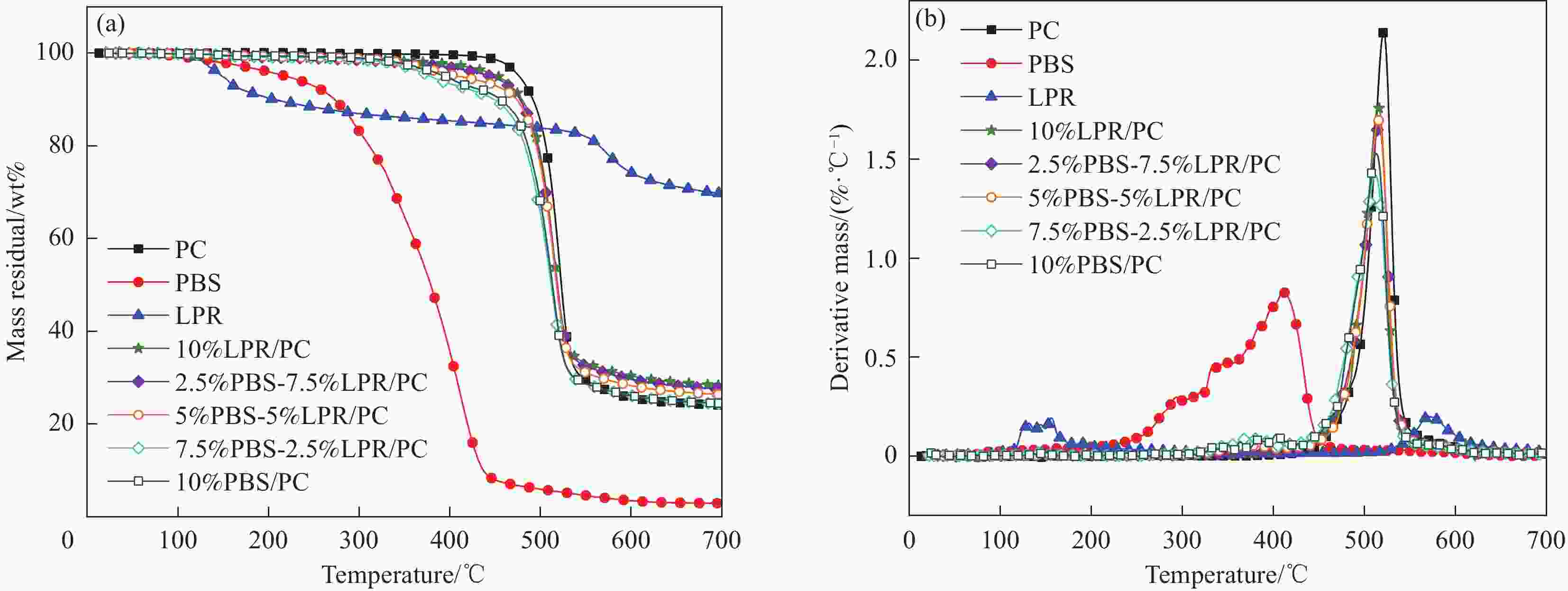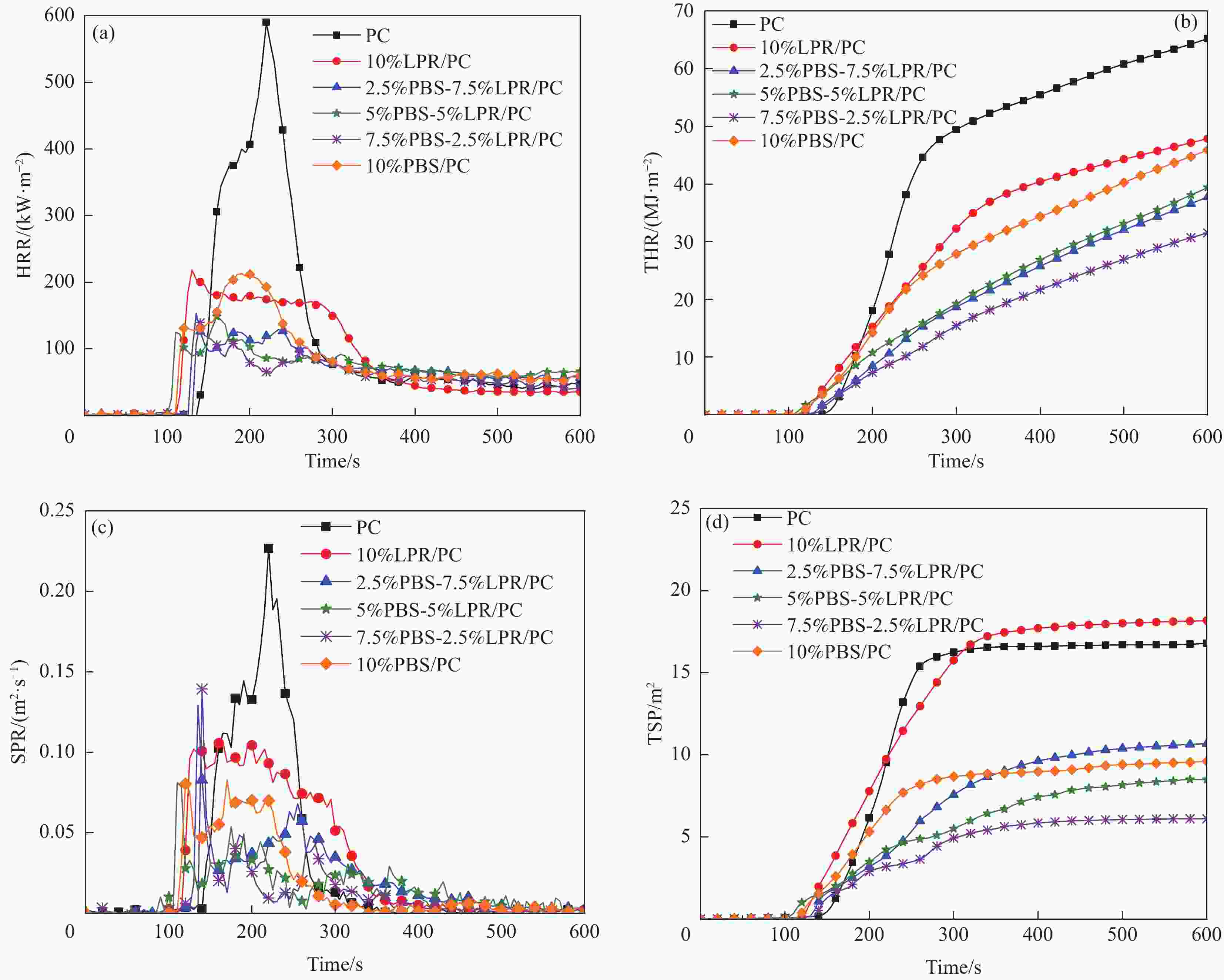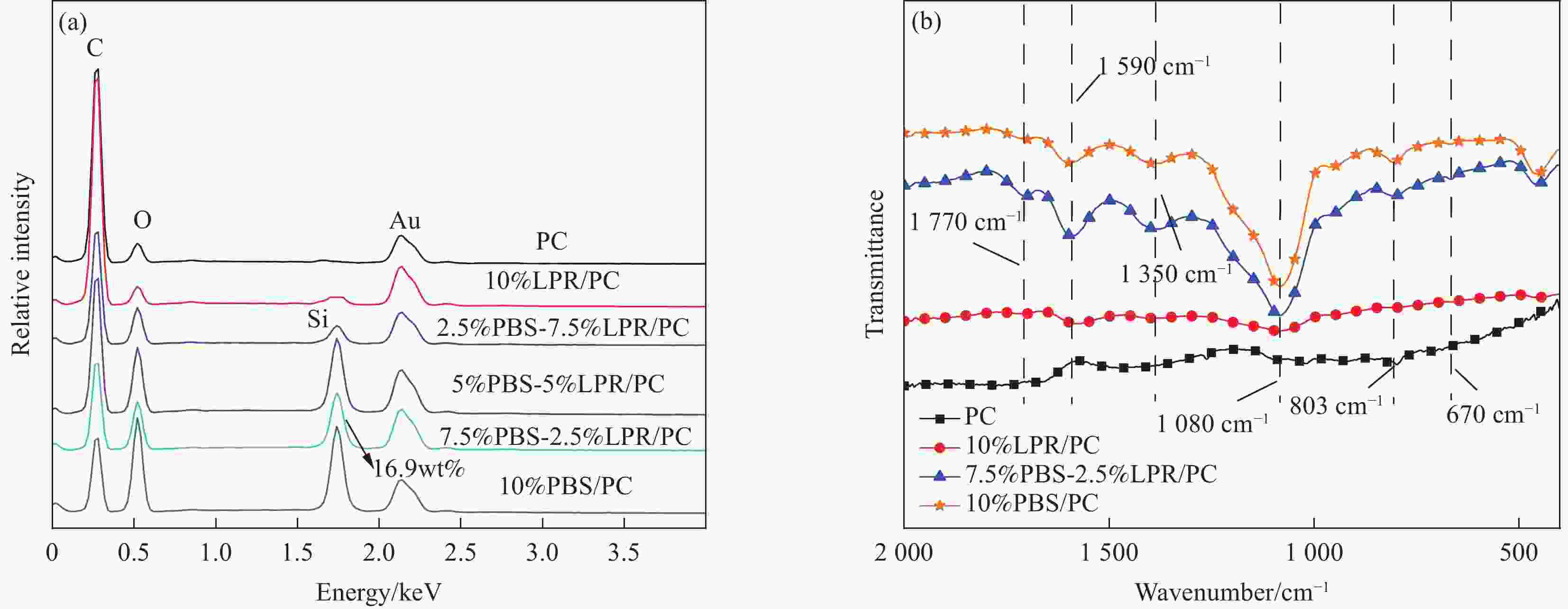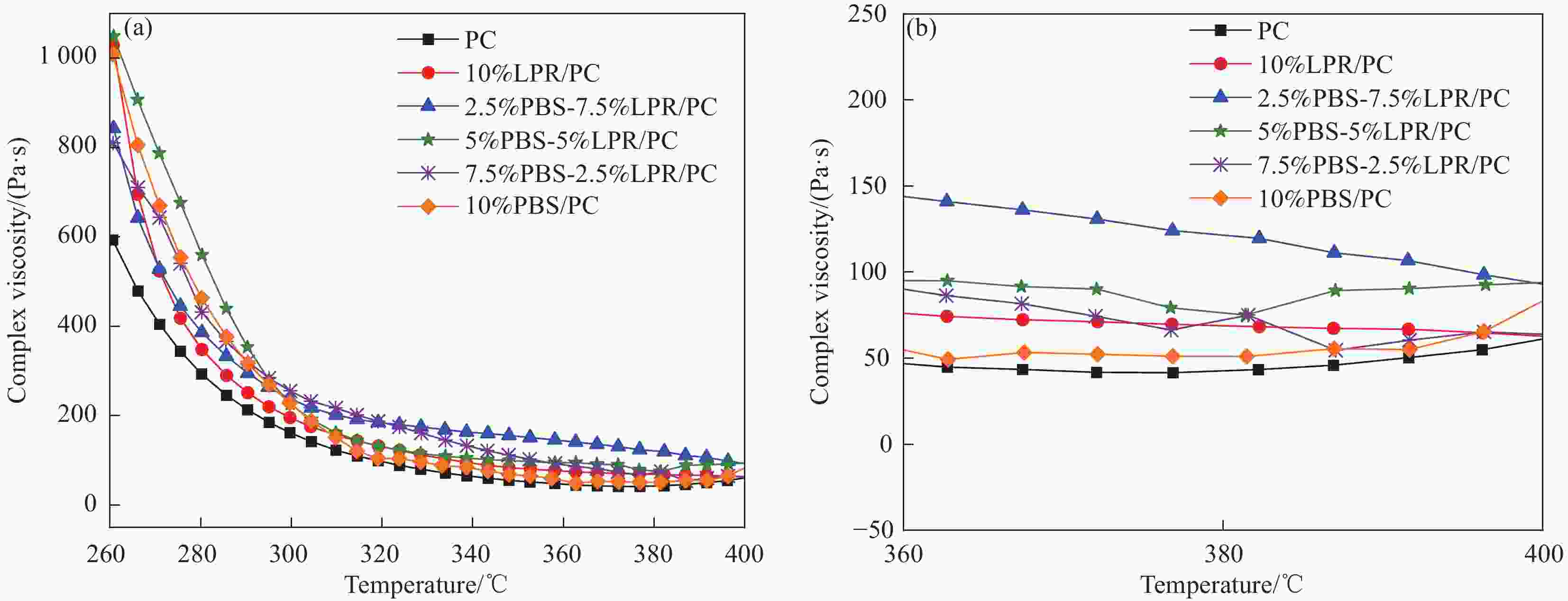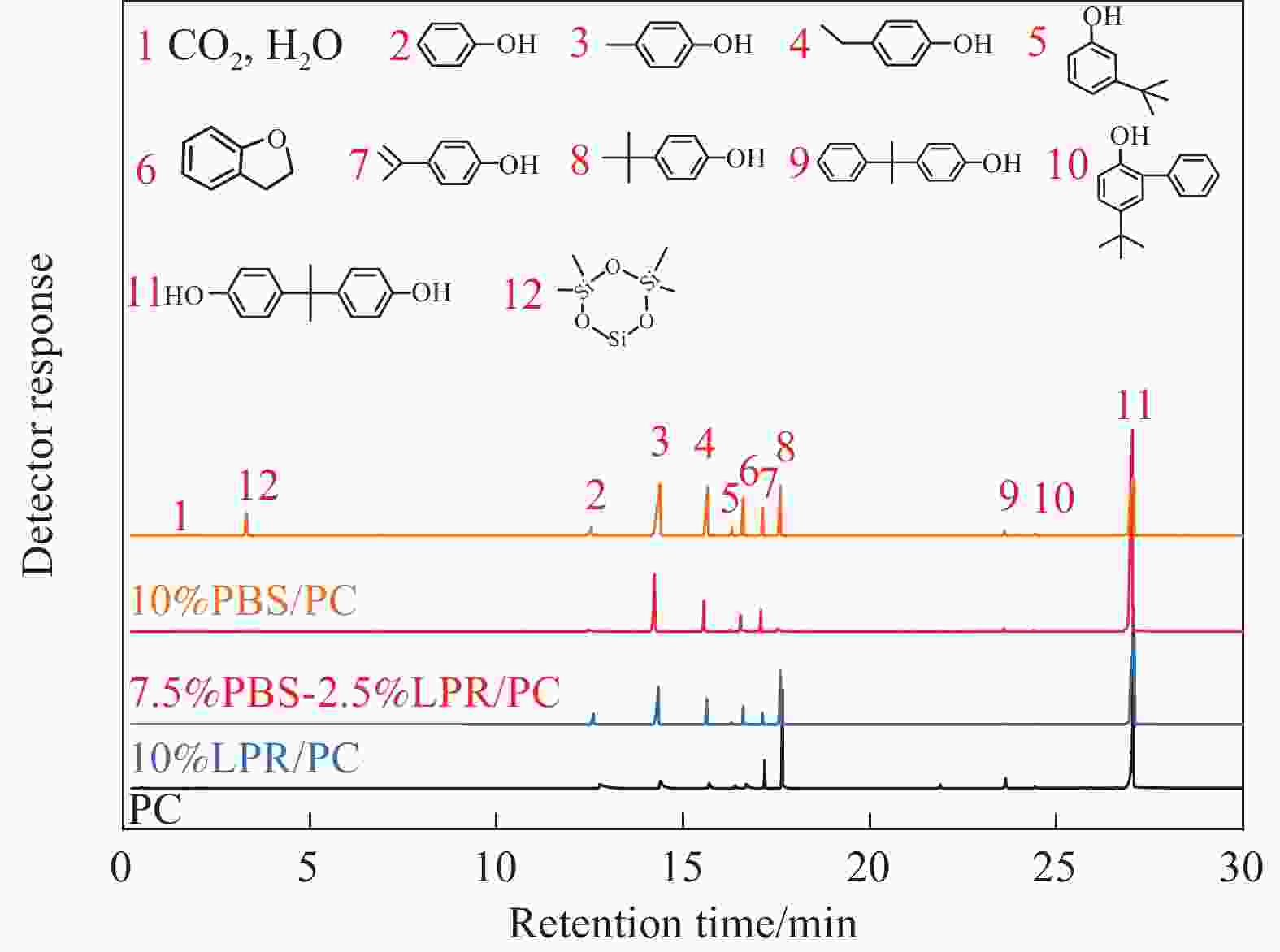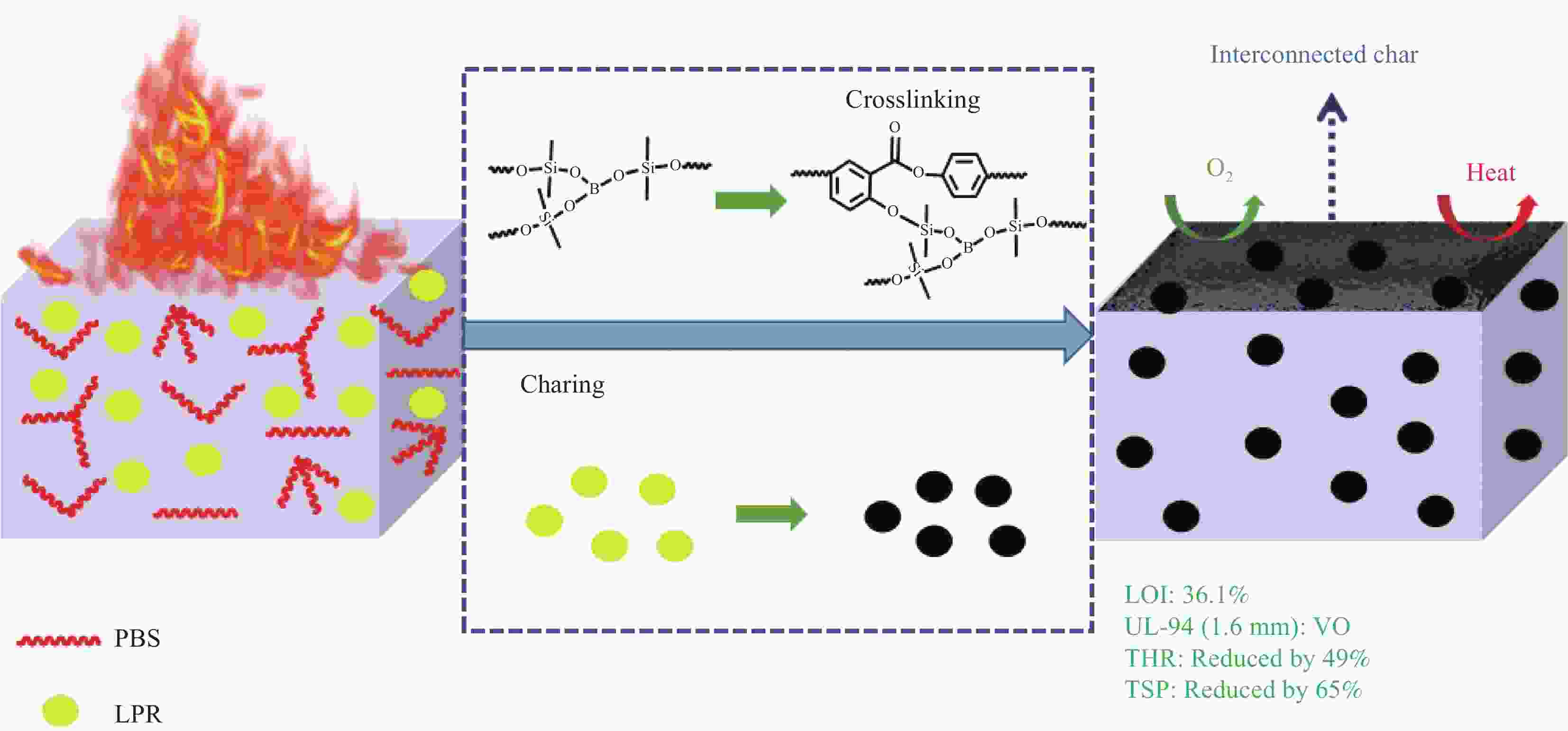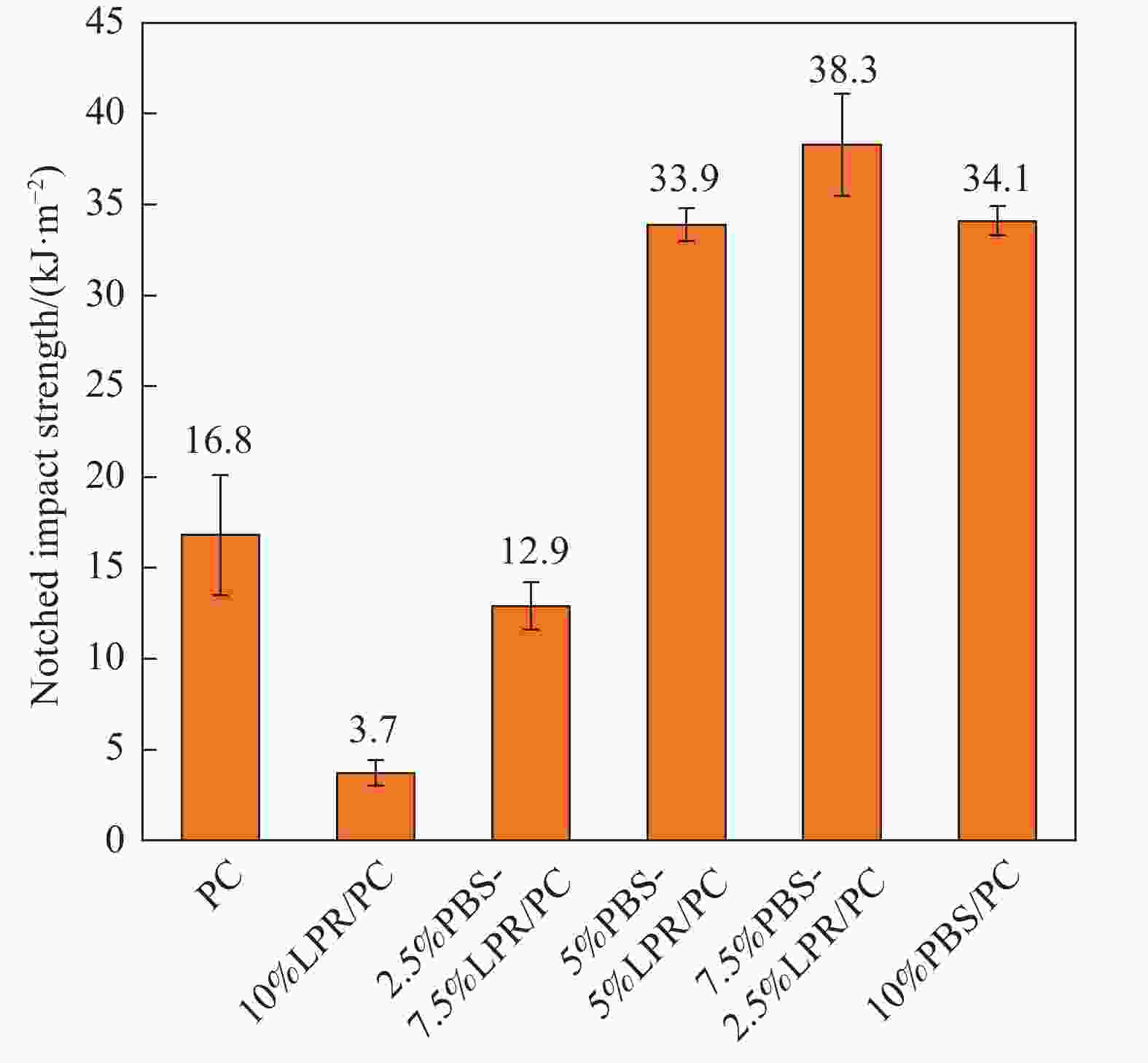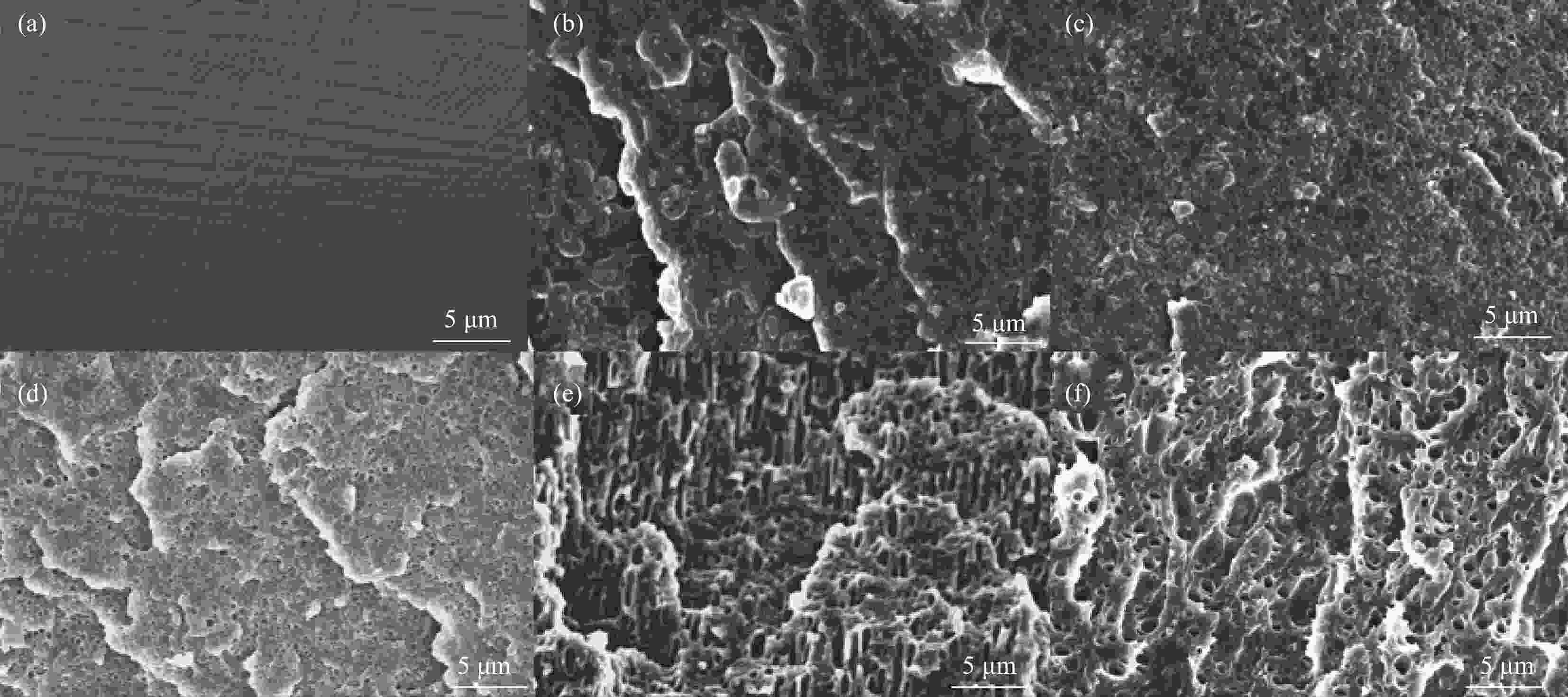Preparation and properties of thin-wall flame-retardant polycarbonate materials with low heat release and smoke
-
摘要: 兼具低烟低热和薄壁阻燃的无卤无氟聚碳酸酯(PC)的制备是该领域面临的一个挑战。以八甲基环四硅氧烷和硼酸为原料,通过缩聚反应制备了一种聚硼硅氧烷(PBS)阻燃剂,将其与硼酚醛树脂(LPR)复配制备了PBS-LPR/PC复合材料。结果表明:在PBS和LPR总添加量为10wt%、质量比3∶1时,在PC中表现出最佳的协同阻燃效果,1.6 mm厚的PC样品能够通过UL-94垂直燃烧测试的V-0级别。与PC相比,该样品的峰值放热率(pHRR)、峰值产烟率(pSPR)、总热释放(THR)和总烟生成(TSP)分别降低了76%、64%、49%和65%。阻燃机制研究表明:PBS和PC的交联成炭以及LPR的原位成炭是阻燃性能提高的主要原因。7.5%PBS-2.5%LPR/PC的缺口冲击强度是PC的2.3倍,材料表现出高韧的特性。Abstract: The preparation of halogen-free and fluorine-free thin-wall flame-retardant polycarbonate (PC) with low smoke and heat release was a challenge in the field. Polyborosiloxane (PBS) flame retardant was prepared by polycondensation reaction between octamethyl cyclotetrasiloxane and boric acid, and then compounded with boron-phenolic resin (LPR) to prepare PBS-LPR/PC composites. The results show that when the total amount of PBS and LPR is 10wt% and the mass ratio is 3∶1, the best flame-retardant effect is shown in PC, the 1.6 mm thick PC sample can pass UL-94 V-0 rating. Compared with that of pure PC, the peak heat release rate (pHRR), the peak smoke production rate (pSPR), the total heat release (THR) and the total smoke production (TSP) of sample reduces by 76%, 64%, 49% and 65%, respectively. The investigation on flame-retardant mechanism show that LPR decreases the viscosity of PC composites first and then increases, which confirms the generation of cross-linking reaction. The notched impact strength of 7.5%PBS-2.5%LPR/PC is 2.3 times that of PC, which makes the material show high toughness.
-
Key words:
- polycarbonate /
- borosiloxane /
- phenolic resin /
- thin-walled flame retardant /
- low smoke and low heat
-
图 4 PC (a)、10%LPR/PC (b)、2.5%PBS-7.5%LPR/PC (c)、5%PBS-5%LPR/PC (d)、7.5%PBS-2.5%LPR/PC (e)、10%PBS/PC (f)复合材料锥形量热测试后残炭的数码照片和SEM图像:(((a)~(f)), ((a1)~(f1)))分别为顶部和侧面残炭外观形貌;((a2)~(f2)) SEM图像
Figure 4. Digital photos and SEM images of char residues from PC (a), 10%LPR/PC (b), 2.5%PBS-7.5%LPR/PC (c), 5%PBS-5%LPR/PC (d), 7.5%PBS-2.5%LPR/PC (e), 10%PBS/PC (f) composites after the cone calorimeter: (((a)-(f)), ((a1)-(f1))) Top and side morphologies; ((a2)-(f2)) SEM image
表 1 PBS-硼酚醛树脂(LPR)/聚碳酸酯(PC)复合材料的组成
Table 1. Composition of PBS-boron-phenolic resin (LPR)/polycarbonate (PC) composites
Sample PC/wt% PBS/wt% LPR/wt% PC 100.0 0.0 0.0 10%LPR/PC 90.0 0.0 10.0 2.5%PBS-7.5%LPR/PC 90.0 2.5 7.5 5%PBS-5%LPR/PC 90.0 5.0 5.0 7.5%PBS-2.5%LPR/PC 90.0 7.5 2.5 10%PBS/PC 90.0 10.0 0.0 表 2 PC和PBS-LPR/PC复合材料在氮气气氛下的热稳定性数据
Table 2. Thermal stability data of PC and PBS-LPR/PC composites in nitrogen atmosphere
Sample T5%/℃ Tmax/℃ Residue/wt% PC 476 521 24.0 PBS 219 407 2.8 LPR 148 573 69.7 10%LPR/PC 452 517 28.3 2.5%PBS-7.5%LPR/PC 445 515 27.5 5%PBS-5%LPR/PC 408 516 26.4 7.5%PBS-2.5%LPR/PC 378 512 24.3 10%PBS/PC 394 512 24.4 Notes: T5%—5wt% decomposition temperature in the first; Tmax—Maximum decomposition temperature. 表 3 PC和PBS-LPR/PC复合材料的极限氧指数(LOI)和UL-94数据
Table 3. Limiting oxygen index (LOI) and UL-94 data of PC and PBS-LPR/PC composites
Sample LOI/% UL-94 (1.6 mm) t1/s t2/s Dripping Rating PC 27.2 19.5±2.2 4.6±1.7 Yes V-2 10%LPR/PC 28.8 18.6±16.5 0.9±0.2 Yes V-2 2.5%PBS-7.5%LPR/PC 35.8 27.2±22.1 24.8±21.0 Yes NR 5%PBS-5%LPR/PC 32.1 6.2±4.2 2.6±1.9 No V-0 7.5%PBS-2.5%LPR/PC 36.1 4.9±2.7 1.7±1.1 No V-0 10%PBS/PC 32.9 3.1±1.1 5.6±5.6 Yes V-2 Notes: t1—Self-extinguishing time after the first ignition;t2—Self-extinguishing time after the second ignition. 表 4 PC及PBS-LPR/PC复合材料的锥形量热测试数据
Table 4. Data of cone calorimeter for PC and PBS-LPR/PC composites
Sample TTI/s pHRR/(kW·m−2) THR/(MJ·m−2) pSPR/(m2·s−1) TSP/m2 MARHE/(kW·m−2) FPI/(m2·s·kW−1) CHR/wt% PC 138 590 65.9 0.22 16.8 172 0.223 19.1 10%LPR/PC 115 218 49.2 0.10 18.2 109 0.528 21.6 2.5%PBS-7.5%LPR/PC 129 153 43.1 0.07 10.7 65 0.843 38.1 5%PBS-5%LPR/PC 107 149 40.7 0.08 8.4 67 0.718 32.8 7.5%PBS-2.5%LPR/PC 135 139 33.4 0.08 5.9 54 0.969 30.0 10%PBS/PC 114 212 51.8 0.07 9.7 93 0.538 18.4 Notes: TTI—Time to ignition; pHRR—Peak heat release rate; THR—Total heat release at 600 s; pSPR—Peak smoke production rate; TSP—Total smoke production at 600 s; MARHE—Maximum average heat release rate; FPI—Fire performance index; CHR—Char residue. 表 5 GC/MS测定PC及其复合材料主要降解产物组成
Table 5. Composition of the main degradation products from PC and its composites obtained by GC/MS measurements
Number Structure PC/% 10%LPR/PC/% 7.5%PBS-2.5%LPR/PC/% 10%PBS/PC/% 1 CO2, H2O 0.7 0.6 1.04 0.5 2 
5.8 3.1 1.26 2.3 3 
5.6 13.6 11.6 24.6 4 
2.6 5.2 4.1 6.2 5 
3.6 0 2.6 0.9 7 
4.1 10.7 1.3 3.7 8 
17.9 2.0 0 9.3 Monophenolics 40.3 35.2 21.9 47.5 11 
56.1 61.1 72.3 31.9 6 
0.5 3.2 4.8 6.3 9 
2.8 0.3 0.4 0.7 10 
0.1 0.2 0.2 0.4 12 
0 0 0.4 5.2 -
[1] LIU Z, MA M, GE B, et al. Toward flame-retardant, transparency, and high mechanical property of polycarbonate based on low addition of linear polyborosiloxane[J]. Chemical Engineering Journal, 2023, 474: 145799. doi: 10.1016/j.cej.2023.145799 [2] YU R H, LIU J, GAO D D, et al. Striking effect of nanosized carbon black modified by grafting sodium sulfonate on improving the flame retardancy of polycarbonate[J]. Composites Communications, 2020, 20: 100359. doi: 10.1016/j.coco.2020.100359 [3] LIU S M, YANG Y, JIANG Z J. Synergistic flame retardant effect of poly(ethersulfones) and polysiloxane on polycarbonate[J]. Journal of Applied Polymer Science, 2012, 124(6): 4502-4511. [4] DING Z, WANG S, GE J, et al. Flame-retardant epoxy resin: Synergistic effect between aluminum diethylphosphinate and piperazine pyrophosphate[J]. Iranian Polymer Journal, 2024, 33(2):119-129. [5] NI P, FANG Y, QIAN L, et al. Flame-retardant behavior of a phosphorus/silicon compound on polycarbonate[J]. Journal of Applied Polymer Science, 2017, 135: 45815-45822. [6] WANG S, YANG X, LI Z, et al. Novel eco-friendly maleopimaric acid based polysiloxane flame retardant and application in rigid polyurethanefoam[J]. Composites Science and Technology, 2020, 198: 108272. doi: 10.1016/j.compscitech.2020.108272 [7] WANG Z, QIU Y, LIU A, et al. Micro-crosslinking of phosphaphenanthrene/siloxane molecule initiate aggregation flame retardant and toughening enhancement effects on its polycarbonate composite[J]. Chemical Engineering Journal, 2023, 466: 143169. doi: 10.1016/j.cej.2023.143169 [8] 刘春雷, 刘颖, 吴大鸣. 无卤阻燃聚碳酸酯薄壁材料[J]. 塑料, 2010, 39(6): 63-65.LIU Chunlei, LIU Ying, WU Daming. Halogen-free flame retardant polycarbonate thin-walled material[J]. Plastic, 2010, 39(6): 63-65(in Chinese). [9] HUANG H, SHI Y, LYU G, et al. Flame resistance and aging mechanism of flame retardant polycarbonate sheet containing linear phenolic resin charring agent[J]. Polymer Degradation and Stability, 2015, 122: 139-145. [10] 岑茵, 吴俊, 王培涛, 等. 薄壁阻燃聚碳酸酯的研究[J]. 塑料工业, 2018, 46(4): 142-146.CEN Yin, WU Jun, WANG Peitao, et al. The study of thin wall flame retardant polycarbonate[J]. Plastic Industry, 2018, 46(4): 142-146(in Chinese). [11] ZHU Y, YU R H, WANG S D, et al. Unexpected core-shell char from polycarbonate/polyborosiloxane composites and its application in improving flame retardancy[J]. Chemical Engineering Journal, 2022, 446: 136742. doi: 10.1016/j.cej.2022.136742 [12] WAN Y, YU S, JIANG S, et al. Microscopic pyrolysis mechanism on the octyphenylsiloxane flame retarded polycarbonate by reactive molecular dynamics[J]. Journal of Analytical and Applied Pyrolysis, 2021, 158: 105274. doi: 10.1016/j.jaap.2021.105274 [13] TANG T, CHEN X, CHEN H, et al. Catalyzing carbonization of polypropylene itself by supported nickel catalyst during combustion of polypropylene/clay nanocomposite for improving fire retardancy[J]. Chemistry of Materials, 2005, 17(11): 2799-2802. doi: 10.1021/cm047771c [14] TANG T, CHEN X, MENG X, et al. Synthesis of multiwalled carbon nanotubes by catalytic combustion of polypropylene[J]. Angewandte Chemie, 2005, 117(10): 1541-1544. doi: 10.1002/ange.200461506 [15] 王旭, 梁西良. 耐高温酚醛树脂研究进展[J]. 化学与粘合, 2022, 44(2): 162-164.WANG Xu, LIANG Xiliang. The research progress of high temperature-resistant phenolic resin[J]. Chemistry and Adhesion, 2022, 44(2): 162-164(in Chinese). [16] ASTM International. Test method for measuring the comparative burning characteristics of solid plastics in a vertical position: ASTM D3801—20[S]. West Conshohocken: ASTM International, 2020. [17] ASTM International. Standard test method for measuring the minimum oxygen concentration to support candle-like combustion of plastics (oxygen index): ASTM D2863—09[S]. West Conshohocken: ASTM International, 2009. [18] International Organization for Standardization. Reaction to-fire tests: Heat release, smoke production and mass loss rate: Part 1: Heat release rate (cone calorimeter method) and smoke production rate (dynamic measurement): ISO 5660—1[S]. Geneva: International Organization for Standardization, 2015. [19] 王许云, 张军, 张峰, 等. 应用锥形量热法评价聚合物复合材料热释放速率[J]. 复合材料学报, 2004(3): 162-166.WANG Xuyun, ZHANG Jun, ZHANG Feng, et al. The use of cone-shaped heat method evaluation polymer composite material thermal release rate[J]. Acta Materiae Compositae Sinica, 2004(3): 162-166(in Chinese). [20] 中国国家标准化管理委员会. 塑料悬臂梁冲击强度的测定试验方案: GB/T 1843—2008[S]. 北京: 中国标准出版社, 2008.Standardization Administration of the People's Republic of China. Plastic—Determination of izod impact strength: GB/T 1843—2008[S]. Beijing: Standards Press of China, 2008(in Chinese). [21] ZHANG L, ZHANG Y, WANG L, et al. Phenolic resin modified by boron-silicon with high char yield[J]. Polymer Testing, 2019, 73: 208-213. doi: 10.1016/j.polymertesting.2018.11.033 [22] 李文洋. 硼酚醛树脂基复合材料用胶黏剂制备及性能研究[D]. 济南: 山东建筑大学, 2023.LI Wenyang. Bonoline-based resin base composite materials are prepared and performance research for adhesives[D]. Jinan: Shandong University of Architecture, 2023(in Chinese). [23] YANG R, CHEN L, ZHANG W Q, et al. In situ reinforced and flame-retarded polycarbonate by a novel phosphorus-containing thermotropic liquid crystalline copolyester[J]. Polymer, 2011, 52(18): 4150-4157. doi: 10.1016/j.polymer.2011.06.047 [24] 高纳川, 高雪雨, 闫莉, 等. 多功能阻燃增韧剂对聚碳酸酯阻燃和力学性能的影响[J]. 复合材料学报, 2024, 41(5): 2395-2403.GAO Nachuan, GAO Xueyu, YAN Li, et al. Effect of multifunctional flame retardant toughenerson the flame retardant and mechanical properties of polycarbonates[J]. Acta Materiae Compositae Sinica, 2024, 41(5): 2395-2403(in Chinese). [25] CHEN D, ZHANG Y, HE J, et al. Making polycarbonate flame retardant: Flame retardant selection and calorimetric analyses[J]. Polymer Testing, 2023, 117: 107876. doi: 10.1016/j.polymertesting.2022.107876 [26] 何吉来, 金小涵, 宁淑慧, 等. 氮硫硅协效阻燃剂的合成及在聚碳酸酯中的应用[J]. 高分子材料科学与工程, 2021, 37(7): 87-94.HE Jilai, JIN Xiaohan, NING Shuhui, et al. The synthesis of nitrogen-sulfur-silicon synergistic flame retardant and the application in polycarbonate[J]. Polymer Materials Science & Engineering, 2021, 37(7): 87-94(in Chinese). [27] JANG B N, WILKIE C A. A TGA/FTIR and mass spectral study on the thermal degradation of bisphenol A polycarbonate[J]. Polymer Degradationand Stability, 2004, 86(3): 419-430. doi: 10.1016/j.polymdegradstab.2004.05.009 [28] YANG S, LYU G, LIU Y, et al. Synergism of polysiloxane and zinc borate flame retardant polycarbonate[J]. Polymer Degradation and Stability, 2013, 98(12): 2795-2800. doi: 10.1016/j.polymdegradstab.2013.10.017 [29] CHEN W, LIU P, CHENG Y, et al. Flame retardancy mechanisms of melamine cyanurate in combination with aluminum diethylphosphinate in epoxy resin[J]. Journal of Applied Polymer Science, 2019, 136(12): 47223. doi: 10.1002/app.47223 -






 下载:
下载:
